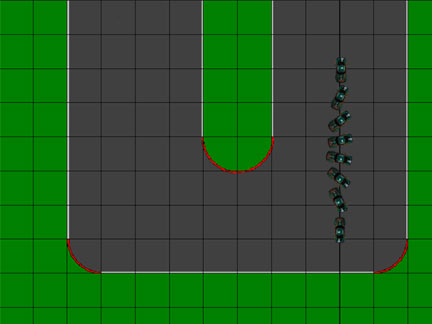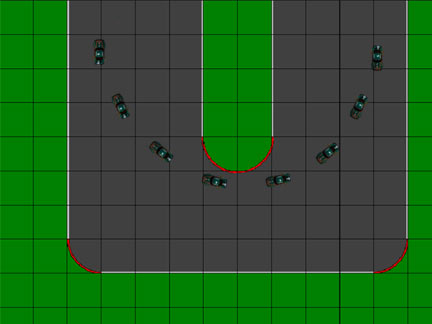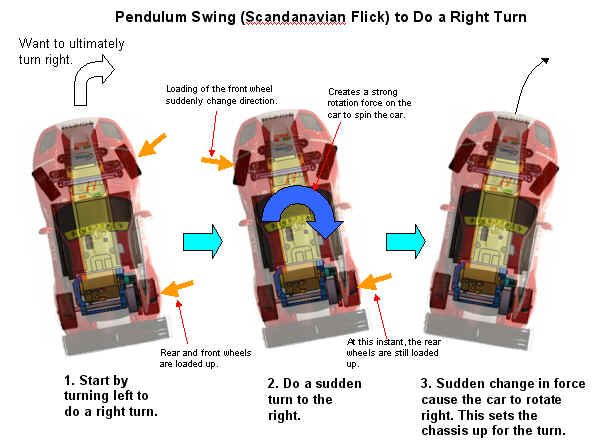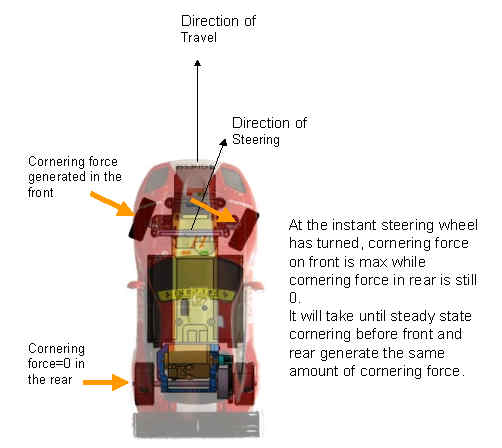 Translation
(Note, if car was a grocery cart, it can take corner without rotation)
Translation
(Note, if car was a grocery cart, it can take corner without rotation)Driving
Disclaimer: There are lots of theories on chassis handling and driving. This is one version of it. It may not be the complete story. The interaction between body, wheels and the road is so complicated probably nobody knows all the science behind it. Those who spend millions of dollars studying it probably won't be willing to divulge their secrets either.
This section describes how to make the car go fast. Going fast on the straight way is easy. All it takes is a fast motor and well charged batteries. Cornering is where race can be won or lost.
From a physics point of view, a car cornering consist of two events. There has to be translation and rotation. Translation is where cornering grip comes into play. The higher g force a car can hold, the faster the translation around the corner. Tranlation alone is useless, the car also must rotate around. The two actions are completely independently of each other. If there were no roads, and car is floating in space, then one action does not affect the other. Rotation is like a flywheel, it takes some force to get it spinning. Once it spins, it will continue to spin until it is stopped. The force it takes to rotate the car around happens in the very beginning of the turn. Once the car has started to rotated, it continues thru the turn without any help until the end of the turn when rotation needs to be stopped.
Starting and stopping the rotation of the car takes force, and generating force takes time in a race.
The theory of traction circle states that the same amount of traction is avalible in any direction. If some traction is used in braking, then less can be used for cornerning. Or if car is cornering, then the same tire won't have any traction to do acceleration. Therefore, if you want to corner, then you can accelerate. Is one or the other. You got 3 things to do in a corner, 1) brake to slow down, 2) generate cornering g force, and 3) rotate the car at the beginning of the corner and stop rotation at the end. Do them at the right moment and you win the race. Easy :)
 Translation
(Note, if car was a grocery cart, it can take corner without rotation)
Translation
(Note, if car was a grocery cart, it can take corner without rotation)
+
 Rotation
(If car was a grocery cart, it can spin while going straight)
Rotation
(If car was a grocery cart, it can spin while going straight)
=
 Since rear wheels does
not steer, cornering requires both rotation and translation.
Since rear wheels does
not steer, cornering requires both rotation and translation.
Mini-z is different than real car in that it is rear wheel drive and rear wheel braking only. There is no brakes on the front wheel. Different cornering techniques will have to be used to take the best advantage of it. Like the old saying, if you want to go fast, learn to use the brakes. In Mini-z without front brakes, different techniques will be required to compensate for it.
Scandanavian Flick or Pendulum Swing
As you approach the corner, turn opposite direction first, then flick the car
into the corner..
When you turn the front wheel left, cornering forces push the front and rear wheel left. What happen when you suddenly turn the front wheel the opposite direction to the right. Instantly, cornering force go away from the front wheel. Is no longer generating left force. Instead, is generating right cornering force. But what happen to the rear wheel. It is still generating left force. So what you have is front wheel is generating right force, and rear is generating left force. That is a huge amount of force to spin the car in a violent manner to set ti up for the corner. In a real car, you can spin out even a understeering front wheel car with this manuver.
Per Colin McRae in an interview on Youtube, this style of driving is usually not used in rally anymore. Use to be popular in the 70's when front brakes were not very good, so driving swing the car into the corner with 4 wheel drift to slow it down. If you just press the brakes in an old car, the front wheel will lockup, and understeer into the trees. Now with AWD and better chassis and brakes, rally cars simply brake and turn, and use hand brake for sharper corners. Too much swaying of the car tends to make it slower. Most drivers now prefer smooth driving.
However, Mini-Z is like an old car with poor front brakes. Infact, it has no front brakes. This kind of turn would make sense. It spins the car into a drift to slow down the car, and also points the car at the corner exit to accelerate earlier.

Another way to get the front wheel to do some braking. When you steer, it the same as braking. Is obvious if you want the car to go as fast as possible, the front wheel should be pointed straight. Everyone knows the car slows down whey you steer. Therefore, if you do want to slow down, steer the front wheels. This is especially true if car is set up to understeer. If you snap the front wheels to turn suddenly, the entire car can't react that fast, so the front wheel is turned while the car is still moving forward. This scrubs off speed. Use the motor to brake the rear. Now you have 4 wheel braking. That should slow the car down enough for the corner.
When the rear wheel brakes, weight transfer goes to the front and adds traction. If the front is set up to understeer by a slight amount, with rear braking, traction is added to the front to compensate the understeer. So you have both braking and steering.

Hand Brake Rear Turn
In the beginning of the corner, once steering wheel is turned, blip the rear
brake to momentary reduce rear traction. This will start the car spinning sideway
to scrub off speed and point the front to the exit. On a grippy track can cause
a roll over. For a grippy track, super glue on the edge of the tire is a must
so edge of the tire does not flap around and cause momentary loss of traction
followed by sudden gain of traction again. Also, on a grippy track, cutting
the rubber down to minimum thickness with a tire cutter like the Hudy
one will increase tire stiffness and reduce roll over. Alternately, use
an old tires. Lowering the car also helps with roll over.
The classical way around the corner is the brake before the turn, then do not apply brake while turning. The theory is sound. When braking, you cannot corner. Therefore, best to use all the traction braking, then use all the traction cornering. That way, you maximize traction at all time. However, that is a simplistic way to look at the corner. When you look at the front wheel and the rear wheel independently in a corner, you see a diferent story. As shown above, cornering consist of rotation and translation. In the beginning of the corner, the front wheel is doing all the work trying to rotate the car. The car does not have much angular rotation yet. Therefore, the rear wheels are not generating the maximum grip yet. Look at it this way, the front wheels can steer, so it can generate side force immediately as you turn the wheel. The rear wheel is parallel to the car chassis. The only time the rear wheel generate side force is if the entire chassis rotates causing the rear wheel to generate side force. Therefore, at the beginning of a turn, the rear wheels still have some grip left over for you to take advantage of.

In trail braking, you do not brake early, and stop braking when starting to turn the steering wheel. You brake late, and continue to brake as you turn the steering wheel. What braking does is the weight transfer from braking puts more traction up front where it needs it. At the same time lightens up the rear where is not generating much traction anyway yet. Word of caution is as the car rotates and the rear is asked to generate side force, you have to lighten up the brake force. Otherwise, it will result in a spin out. The sequence is brake late, and continue to brake while turning the front wheel. As the car start to generate side g force, gradually let up on the brake. In mid corner where is steady state turning, there should be no brakes. Then accelerate out of the corner.
In Mini-z, there is only the rear brake, but trail braking should still apply. Using steering as braking to accomplish the braking deep into the corner. Gradually let go of the motor braking and let up on steering as the car start to transition to steady state corner. Accelerate out when you are at the point where you can apply full throttle.
Best Technique
Difficult to say which is the best. When you are accelerating out of several
corners, pendulum swing may be the best. As you accelerate, car usually understeer,
so swinging the car into the corner helps the car turn. Watching video of good
rally driving, that seems to be what they do. Front wheel braking may be good
for fast corners. Hand brake rear turn is probably best of very tight corner
when you are coming in fast just like in rally. Comparison of Mini-z to rally
is probably more relistic than comparison to road racing because mini-z chassis
only have rear wheel braking, and therefore tend to drift thru corner more than
road racing.
Links:
http://www.peterkrause.net/Krause_%26_Associates_LLC/Track_Wisdom.html
http://www.onehotlap.com/2012/03/few-thoughts-on-cornering-101.html